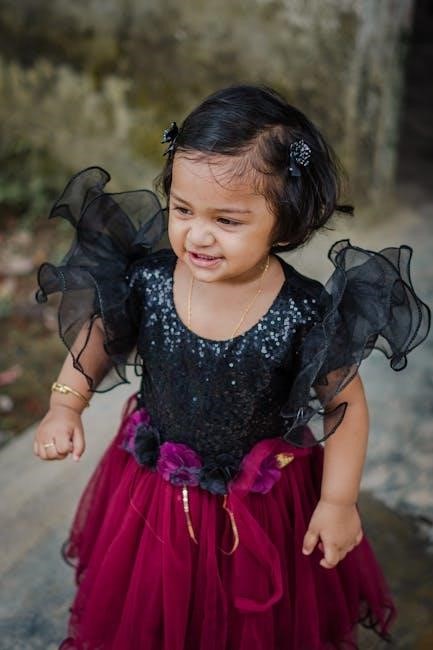Paracord bracelets are versatile accessories known for their durability and practicality‚ offering both style and functionality. Popular in military and outdoor circles‚ they serve as survival tools and fashion statements‚ gaining widespread appeal as creative DIY projects.
What Are Paracord Bracelets?
Paracord bracelets are durable‚ versatile accessories made from high-strength paracord‚ typically used for survival and outdoor activities. They are woven into intricate designs‚ often featuring knots like the cobra stitch‚ and are popular for their practicality and style. These bracelets can be unraveled to provide a reliable source of cordage in emergencies‚ making them essential for camping‚ hiking‚ or military use. Their popularity has grown as DIY projects‚ with many creators sharing customizable patterns and designs‚ from simple to complex‚ appealing to both enthusiasts and survivalists alike.
The Popularity of Paracord Bracelets
Paracord bracelets have gained immense popularity due to their versatility‚ durability‚ and aesthetic appeal. They are cherished by outdoor enthusiasts‚ survivalists‚ and fashion-conscious individuals alike; The ability to customize designs‚ colors‚ and patterns has made them a trend in DIY crafting communities. Their practical use as emergency cordage adds functional value‚ while their stylish designs attract those seeking unique accessories. Easy access to tutorials and guides has further fueled their popularity‚ making them a favorite project for crafters of all skill levels‚ from beginners to seasoned experts‚ worldwide.
Materials and Tools Needed
To craft a paracord bracelet‚ you’ll need high-quality paracord‚ a measuring tape‚ scissors‚ a lighter‚ and a buckle or knotting tool for securing the design.
Types of Paracord
Paracord is categorized into different types based on its strength and durability. The most common is Type III‚ also known as 550 paracord‚ which can hold up to 550 pounds. It features seven strands of nylon‚ making it ideal for survival bracelets. Type IV is stronger‚ with a 750-pound capacity‚ but less commonly used for bracelets due to its bulkiness. Type II and Type I are lighter but less durable‚ often used for decorative purposes rather than functional survival gear.
Essential Tools for Making Paracord Bracelets
The primary tools needed include sharp scissors or a paracord cutter‚ a lighter for melting ends‚ and a measuring tape for sizing. A sturdy work surface is also recommended to ensure stability while weaving. Optional tools like cord clips or boards can help keep strands organized‚ making the process smoother. These basic tools enable precise cutting‚ secure ends‚ and accurate measurements‚ ensuring a professional finish for your bracelet.
Basic Knots for Paracord Bracelets
Mastering essential knots like the Monkey Fist‚ Overhand Knot‚ and Cobra Stitch is crucial for creating durable and stylish paracord bracelets. These foundational knots ensure strength and aesthetics.
Monkey Fist Knot
The Monkey Fist Knot is a decorative and functional knot used in paracord bracelets. It creates a bulbous end‚ often used as a durable anchor point. To tie it‚ loop the paracord around your hand three times‚ pass the ends through the center‚ and tighten. This knot is ideal for creating a secure stopper or adding a stylish touch to bracelets. It’s a popular choice for both beginners and experienced crafters‚ offering a balance of form and function.
Overhand Knot
The Overhand Knot is a simple yet essential knot used in paracord bracelet making. It is often the starting point for more complex knots and patterns. To tie it‚ form a loop with the paracord‚ pass the ends through the loop‚ and tighten. This knot is versatile and forms the foundation for various bracelet designs. It’s easy to learn and serves as a secure way to begin or end a project. The Overhand Knot is a must-know for anyone creating paracord accessories‚ as it provides a reliable base for further knotting techniques.
Cobra Stitch
The Cobra Stitch is a popular knotting technique used in paracord bracelet making‚ creating a strong and sleek design. It involves weaving the paracord in an alternating pattern‚ forming a dense and flexible bracelet. This stitch is ideal for survival bracelets due to its durability and functionality. The Cobra Stitch is a favorite among both beginners and experienced crafters‚ as it offers a clean‚ professional look while maintaining the practicality of paracord. It’s a key technique for anyone looking to create stylish and functional paracord accessories.
Step-by-Step Guide to Making a Paracord Bracelet
Measure‚ cut‚ and secure the paracord‚ then weave it into your desired pattern. Finish by tying knots and trimming excess. Detailed instructions are provided in the guide.
Measuring and Cutting the Paracord
Measuring and cutting the paracord is the first step in crafting a bracelet. Typically‚ 8 feet of paracord is recommended for an average-sized wrist. Measure the length against your wrist to ensure a proper fit. Use sharp scissors or a utility knife to cut the paracord cleanly. It’s important to leave a little extra length for knot tying. After cutting‚ use a lighter to carefully melt the ends to prevent fraying. This step ensures a professional finish and prevents the paracord from unraveling during the weaving process.
Starting the Bracelet
To start your paracord bracelet‚ secure one end of the cord to a stable object using a knot‚ such as a monkey fist or overhand knot. This prevents the cord from slipping while you work. Form a loop at the starting point‚ ensuring it is large enough to fit around your wrist comfortably. Use a clip or tape to hold the loop in place. This initial loop serves as the foundation for your bracelet. You can also begin by tying a simple knot directly to a keyring or other base if desired. Properly anchoring the cord is essential for maintaining tension and achieving a neat design.
Weaving the Paracord
Weaving the paracord involves crossing strands over and under each other to create intricate patterns. Begin by taking one strand and looping it over the base cord‚ forming a series of knots. The cobra stitch is a popular method‚ where you pass the working cord under and over the base strands alternately. Tighten each knot firmly to maintain a consistent weave. Continue this process‚ ensuring even tension to avoid the bracelet becoming too tight or loose. For more complex designs‚ use additional strands or colors‚ weaving them into the pattern. Use a measuring tape or duct tape to hold strands in place while working. This step requires patience and attention to detail to achieve a professional finish.
Finishing the Bracelet
To complete the bracelet‚ secure the ends by tying an overhand knot or your preferred finishing knot. Trim the excess paracord with scissors or a lighter to prevent fraying. For a polished look‚ melt the cut ends slightly to seal them. Optionally‚ tuck the ends under the previous knots for a neater appearance. Ensure the bracelet is snug but not too tight‚ adjusting the knots if necessary. A well-finished bracelet ensures durability and a professional appearance‚ making it both functional and stylish. Properly sealing the ends is crucial for long-lasting wear.

Customization Options
Personalize your bracelet with vibrant colors and intricate patterns. Add beads‚ charms‚ or metal accents for a unique touch‚ reflecting your personal style and creativity.
Choosing Colors and Patterns
Selecting the right colors and patterns can elevate your paracord bracelet from functional to fashionable. Consider using complementary colors to create visually appealing designs. For instance‚ pairing navy blue with neon green adds a striking contrast. Patterns like the cobra stitch or diamond weave offer texture and uniqueness. You can also match your bracelet to your personal style or favorite outfit. Additionally‚ using multiple colors allows you to represent teams‚ organizations‚ or causes‚ making each bracelet truly one-of-a-kind. This step is where creativity shines‚ so experiment freely!
Adding Beads or Charms
Enhance your paracord bracelet by incorporating beads or charms for a personalized touch. Beads can add texture‚ color‚ and meaning‚ while charms provide a decorative or symbolic element. Choose beads that match your bracelet’s color scheme or go bold with contrasting hues. Sliding beads onto the paracord before weaving allows for precise placement. Charms can be attached using small jump rings or by threading them onto the cord. This step transforms your bracelet into a unique accessory‚ blending functionality with artistic expression. Experiment with different bead styles and charm shapes to create a one-of-a-kind design.

Troubleshooting Common Issues
Common issues include uneven weaving and bracelet size adjustments. Check for consistent tension while weaving and use a ruler to ensure accurate measurements for a proper fit.
Fixing Uneven Weaving
Uneven weaving can occur due to inconsistent tension or loose knots. To fix this‚ gently tighten or loosen specific strands‚ ensuring even spacing between knots. Check each knot for snugness and adjust as needed. Use a ruler to measure and ensure the bracelet lies flat. If weaving is too tight‚ carefully pry apart strands to relax the fabric. For loose areas‚ pull the paracord firmly to tighten. Regularly inspect your work as you go to maintain a balanced and professional finish.
Adjusting the Bracelet Size
To adjust the bracelet size‚ you can add or remove knots to modify the length. For a precise fit‚ measure your wrist and compare it to the bracelet. If it’s too tight‚ gently untie a knot and add more paracord‚ reweaving as needed. If it’s too loose‚ remove a knot and trim the excess. Use a ruler to ensure accuracy. For a quick fix‚ incorporate a sliding knot to make the bracelet adjustable. This method maintains durability while allowing for size customization‚ ensuring a comfortable and secure fit.
The History of Paracord
The Monkey Fist Knot is a popular choice for paracord bracelets‚ offering a decorative and functional element. It involves wrapping the cord around a central knot‚ creating a textured design that adds both style and durability to the bracelet. This knot is often used as a focal point‚ enhancing the overall aesthetic while maintaining the bracelet’s structural integrity.
Origins of Paracord
Paracord‚ short for parachute cord‚ originated during World War II‚ designed for military use in parachutes. Known for its strength and durability‚ it became a versatile survival tool. Initially used by the military‚ its popularity grew among outdoor enthusiasts and survivalists. The paracord’s ability to withstand harsh conditions made it ideal for various applications beyond its original purpose‚ leading to its widespread use in crafting accessories like bracelets. Its history reflects its practicality and adaptability‚ making it a staple in both functional and creative endeavors.
Paracord in Military and Survival Use
Paracord‚ originally designed for military parachutes in WWII‚ is renowned for its strength and versatility. Its 550-pound tensile strength makes it ideal for securing equipment‚ creating shelters‚ and survival situations. In military contexts‚ it’s used for rappelling‚ hoisting‚ and securing gear. For survivalists‚ it serves as a reliable tool for tying knots‚ creating snares‚ and even emergency repelling. Its adaptability has made it a must-have for outdoor enthusiasts‚ ensuring it remains a critical component in both tactical and wilderness scenarios. This practicality is why paracord bracelets are popular‚ offering a portable survival resource.

Survival Uses of Paracord Bracelets
Paracord bracelets provide emergency cord‚ enabling the creation of shelters‚ securing gear‚ and creating snares. They also serve as a durable‚ portable survival resource in wilderness scenarios.
Emergency Cord
A paracord bracelet serves as a reliable emergency cord‚ offering quick access to a strong‚ durable rope. Its 550-paracord core can withstand up to 550 pounds of force‚ making it ideal for securing shelter‚ creating makeshift tow lines‚ or repairing gear. In survival situations‚ the cord can be unraveled and used for various essential tasks‚ such as creating snares or tying down equipment. This feature makes the bracelet an indispensable tool for outdoor enthusiasts and emergency preparedness kits.
Creating Shelters
Paracord bracelets are invaluable for creating shelters in survival situations. By unraveling the bracelet‚ you gain access to a durable cord that can be used as a ridgeline for tarps or tied between trees to secure branches. The 550-paracord’s strength ensures it can hold significant weight‚ making it perfect for constructing lean-to shelters or framing temporary structures. This versatility makes the bracelet an essential tool for outdoor enthusiasts‚ providing reliable support in building shelter during emergencies or wilderness adventures.

Advanced Techniques for Paracord Bracelets
Elevate your craftsmanship with intricate patterns like the double cobra stitch and multi-color designs. These techniques enhance durability and visual appeal‚ offering unique personalization options for enthusiasts.
Double Cobra Stitch
The double cobra stitch is an advanced knotting technique that creates a robust and visually striking paracord bracelet. By weaving two strands of paracord in a crisscross pattern‚ this method ensures maximum durability. It involves creating forward and backward passes with the cord‚ forming a dense and textured design. This stitch is ideal for those seeking a challenging yet rewarding project‚ offering a professional finish. Its popularity stems from its strength and aesthetic appeal‚ making it a favorite among both survival enthusiasts and fashion-conscious crafters. Perfect for experienced makers‚ it showcases skill and precision.
Incorporating Multiple Colors
Incorporating multiple colors into a paracord bracelet enhances its visual appeal and personalizes the design; By using different colored strands‚ creators can craft unique patterns and themes. This technique involves strategically weaving each color to achieve the desired effect‚ whether it’s a subtle gradient or a bold contrast. Popular methods include alternating colors in the cobra stitch or creating segmented patterns. This approach allows for endless creativity‚ making each bracelet a one-of-a-kind accessory. It’s a great way to add personality and style to a functional survival tool.

PDF Resources for Paracord Bracelet Instructions
Discover comprehensive PDF guides offering detailed step-by-step tutorials for crafting paracord bracelets. These downloadable resources provide clear instructions‚ patterns‚ and tips for both beginners and experts.
Downloading Printable Tutorials
Downloadable PDF guides provide easy-to-follow instructions for crafting paracord bracelets. These tutorials often include step-by-step photos‚ diagrams‚ and written instructions for various patterns. Many resources offer free or affordable downloads‚ making it simple to access expert techniques. Printable guides are ideal for beginners‚ offering clear directions for measuring‚ cutting‚ and weaving paracord. They also cover advanced methods like the cobra stitch and incorporating multiple colors. With these tutorials‚ you can learn to create survival bracelets‚ decorative accessories‚ and more from the comfort of your home.
Recommended PDF Guides
Several high-quality PDF guides are available online‚ offering detailed instructions for making paracord bracelets. These guides often include step-by-step tutorials‚ photos‚ and diagrams to help both beginners and experienced crafters. Popular resources like “Ultimate Paracord Projects” and “DIY Survival Bracelets” provide comprehensive instructions for various styles. Many guides are free to download‚ while others offer advanced techniques for a small fee; These PDFs are ideal for learning new patterns‚ such as the cobra stitch or fishtail weave‚ and can be printed for easy reference while crafting.
Creating paracord bracelets is a rewarding craft that combines functionality and style. With practice‚ you can master various patterns‚ making durable and stylish accessories for everyday use.
Final Tips for Making Paracord Bracelets
Always maintain patience and practice to master the stitches. Experiment with colors and patterns to create unique designs. Consider adding beads or charms for personalization. Keep your tools organized and paracord untangled for a smoother process. Regularly review tutorials for new techniques. Store finished bracelets in a dry place to prevent damage. With time and effort‚ you’ll craft durable‚ stylish accessories that serve both practical and fashionable purposes. Wear your creations with pride‚ knowing they reflect your skill and creativity.
The Joy of Creating Paracord Accessories
Creating paracord accessories offers a sense of accomplishment and creativity. Crafting each bracelet by hand allows for personalization‚ making every piece unique. The process can be meditative‚ fostering patience and focus. Seeing a project come to life is rewarding‚ and wearing or gifting your creations adds a personal touch. It’s a hobby that combines practicality with artistry‚ providing a sense of pride and satisfaction. Whether for survival or style‚ making paracord accessories is a fulfilling experience that sparks creativity and connects you to a community of makers.
